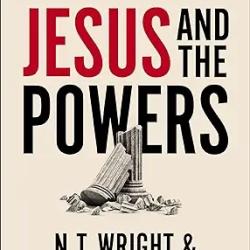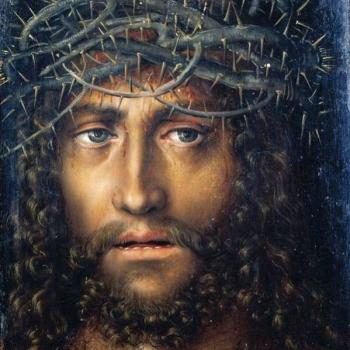On pp. 218-86, the longest single chapter, the Pope will discuss the Johannine question, and it is a good sign that he takes the question so seriously. In short form the question is this—why is the Fourth Gospel so dramatically different from the other three? The Pope is well aware of the history of the discussion of the 4th Gospel in the 20th century and the radical rejection of it’s having much historical substance thanks to Bultmann and others. He also knows that with the finding of papyri from the 2nd century that include portions of John, a second century dating doesn’t work any more for this Gospel. What he also knows is the thorough and convincing rebuttal of Martin Hengel who shows that the supposed Gnostic origins of the Fourth Gospel is historically incorrect. Gnosticism in part developed from this Gospel in the second century, not the other way around. The irony is, that Bultmann’s original thesis, that the 4th Gospel was indebted to early Jewish wisdom ideas, a thesis he abandoned to pick up the Gnostic one, was right. The Fourth Gospel is Christology done through the lens of wisdom ideas and images.
The Pope stresses that the 4th Evangelist reflects a very precise knowledge of times and places in the Holy Land and can only have been produced by someone who had a first hand knowledge of these places, mainly in Judea. As Hengel went on to show, the simple Koine Greek of this Gospel was spoken by upper class Jews in and around Jerusalem, Jews like Lazarus for instance. There was a Hellenized upper class in Jerusalem for a long time before Jesus came on the scene. Hengel locates the 4th Gospel in the priestly aristocracy in Jerusalem.
The Pope gives us an interesting discussion of the authorship question, and he is well aware that there have to have been two figures involved, at least, in the composition of this document— he suggests the latter one who collected the memoirs of the Beloved Disciple, was the elder John referred to by Papias. The Pope also attributes 2-3 John to this person. He is clear enough as well that the Greek of Revelation is difference from the Gospel and 1 John, sufficiently different to suggest separate authorship. He concludes we do have the eyewitness testimony of the BD in the 4th Gospel, later assembled by his literary executor. The problem is he wants to say that John son of Zebedee was also a member of the priestly class and served in Jerusalem twice a year, all the while being a fisherman in Galilee. The historical evidence suggests nothing of the kind, and the first identification of the authorship of this Gospel with John Zebedee does not come until Irenaeus at the end of the second century who was trying to reclaim this Gospel from the Gnostics. He wants to talk about a Johannine school, following Hengel and Stuhlmacher. In addition he thinks John 1.35,40 refers to Zebedee as previously a follower of John the Baptizer, but there is no mention of the Zebedees at all in John 1. This theory creates more problems than it solves as I have shown at length in What Have They Done with Jesus. There are exactly none of the eyewitness stories about Zebedee, traditions he alone could have known that we hear about in the Synoptics, found in the 4th Gospel. This is more than strange if John Zebedee wrote these stories down and insisted it was an eyewitness testimony. Interestingly, The Pope critiques Hengel (see p. 228) for being too much of a historical minimalist when it comes to the 4th Gospel. But it is interesting how much he relies on the two great lights from Tubingen— Hengel and Stuhlmacher.
Here I find the analysis of the Pope, and his critique of his fellow German scholars right on target. Complaining about those scholars who want to say the 4th Gospel account is meant to strengthen faith and should not be seen as an historical account, the Pope rejoinds: “What faith does it ‘testify’ to if, so to speak, it has left history behind? How does it strengthen faith if it presents itself as a historical testimony—and does so quite emphatically—but then does not report history? I think we are dealing here with a false conception of faith and of the Paraclete. A faith that discards history in this manner really turns into ‘Gnosticism’. It leaves flesh, incarnation—just what true history is— behind.” (p. 228).
The Pope is familiar with the suggestion of H. Schurmann that the Sitz im Leben of the I Am discourses was Jesus’ internal discussions with the disciples, not his public teaching. The Pope counters by suggesting they reflect Jesus’ temple debates in Jerusalem with authority figures. The problem with the latter suggestion is they are not like the temple debates with authority figures we find in the Synoptics, they are more like discourses not debates.
The Pope in the end rejects Hengel’s suggestion that in John the theological reflection sometimes violates the historical facts, the Spirit sort of over-riding historical concerns and historical accuracy. The Pope ask how is the Spirit supposed to have the last word, the Spirit that leads into all truth, if in the redaction the Evangelist has already violated the historical record? This is an excellent question. (pp. 229-30). In the Pope’s reconstruction— historical reality and personal reflection form a pair, which the Evangelist knows partly from memory, and partly from church tradition (the Pope thinks the Evangelist knows the Synoptics in some form). The Pope turns to 1 John 1 to show that the witness in the Fourth Gospel stands alongside the church’s witness, as a part of a ‘we’ who have seen and heard and touched. This is a helpful emphasis indicating we should not see this Gospel as the reflections of an eccentric individualist.
On pp. 231-32, the Pope talks about what the word ‘remember’ is connected with in the Fourth Gospel— he turns to John 2 and 12, and the uses there. In the first case it is remembering a Scripture, in the second remembering something Jesus said in light of Scripture, in the third case it is both— correlating the event of Palm Sunday with the text of Zechariah which sheds light on the event, and so understanding how what Jesus did was a fulfillment of Scripture. This is more than just ‘bringing to mind’, this is correlation of event with the Word leading to comprehension of the significance of events. And it is the resurrection— the vindication and glorification of Jesus that leads to this new way of seeing and understanding both Scripture and the previous life of Jesus. Interestingly, on pp. 233-34 the Pope connects this with Mary’s remembering as recorded in Luke 2— remembering, pondering, storing up in the heart. (One wonders, in light of John 19 if Mary and the BD compared notes on the process of ‘anamnesis’ or remembering leading into grasping truth and understanding). The Pope sees the role of the Spirit as spinning out the implications and enhancing the understanding of the historical events, not in a way that violates the historical facts or substance, but in what might be called a way of making connections with Scripture and drawing out the theological significance of the Christ event further. It comports with the events, but explains them in a way that is only latent in the words and deeds of Jesus themselves. The Pope reminds us that the presentation of Jesus is given in the context of the Jewish liturgical calendar of festivals and events. The point in part is that Jesus and his ministry is the fulfillment, in himself of all the things these festivals and rituals were point to— Jesus is the Passover lamb, Jesus is the temple, Jesus is the scapegoat, Jesus is the source of everlasting life, atonement for sin, food for the soul and so on. But by being the fulfillment of all the festivals he is also the completion of them, and when he dies, as he says ‘they are finished’. In short, though the Pope does not say so, there is an implicit supercessionism in this Gospel.
The Pope then turns (pp. 238ff.) to a discussion of some of the major themes or symbols of the 4th Gospel starting with water. Not surprisingly he wants to read John 3 as saying something about baptism, and here he could have used Barrett’s commentary on John which makes clear John is not frankly offered veiled comments on Christian baptism in John 3, any more than he is offering veiled comments on the elements in the meal in John 13. The focus is rather on humble service leading to cleansing in the form of footwashing, which is no part of the Seder meal, or the Lord’s Supper for that matter, despite the later combining of things by the Brethren Church and others. John 13 is in any case not the record of the Last Supper, but a meal earlier in the week. Thus the Pope wants to see baptismal symbolism not merely in John 3, but in most all the water passages— John 4, John 9 and so on. The problem is that water is a broader symbol in early Judaism— a symbol of life, abundant life, and not merely a symbol of cleansing of sin. In John 3 water is a symbol of physical birth— the being born out of water, when the waters break. Hence the next line— flesh gives birth to flesh. Birth by water then is contrasted with the birth again by the Spirit, not equated with it. Yet (p. 243) the Pope has no doubt that the water and blood coming forth from Christ at his death is a symbol of the two sacraments— never mind that blood alone is never a symbol of the Lord’s Supper in the NT. Rather we are here in John 19 given confirmation of the reality of Jesus’ life, and his death. He was no Spirit on the cross, but rather flesh and blood. The portrayal of the death is the ultimate revelation of the depths of the incarnation— he really did take on flesh and dwell amongst us, and die amongst us as one of us. Not surprisingly the sacramental way of viewing these texts leads the Pope to think 1 John 5 is also about the sacraments, but in fact the three witnesses are— the birth of Jesus (symbolized by water) the death of Jesus (symbolized by blood) and the Holy Spirit. This comports with 1 John 1 at the beginning of the discourse where the reality of the incarnation is stressed and the true confession is said to involve believing ‘Jesus truly come in the flesh’. The Spirit’s witness comes in and through the church to the world.
One of the considerable lacunae in the Pope’s presentation here is the failure to read this Gospel in light of the Jewish wisdom tradition, for example Wisdom of Solomon. Jesus is depicted here in John as both the manna from heaven and the water of life, both of which were said of Wisdom in the earlier Wisdom tradition (see Prov. 8-9 in addition to Wis. Sol. ). Indeed, in Wis. Sol. Wisdom is said to be the rock which followed Israel around in the wilderness, from which water came. In 1 Cor. 10 the rock is said to be Christ. The point here is that what is said of Christ in John had been already said of Wisdom is earlier Jewish lit. and so there is a transference of valences here. The Pope prefers the reading of John 7.38 where the ‘body’ from which living waters flow is said to be Christ’s rather than the believer’s, but this does not comport with 1 Cor. 12 where we are told that it is within the believer that the Spirit dwells as source of drink, and in John 4 Jesus said the Samaritan woman would have within herself this unquenchable water if she accepted Him.
The Pope next turns to the symbolism of wine and the vine (pp. 248ff.) and here the discussion is somewhat less helpful. He is right to connect this with the notion of Jesus the bridegroom, and the coming messianic banquet perhaps, but the replacement motif in John 2 at Cana is hard to miss— lifeless purification water is turned into new wine, a symbol of the Gospel and its vivifying effect. John 15 presents Jesus as the vine and the Father as the vinedresser, and the Pope is right to note the echo of Isaiah 5, where the vine or vineyard is Israel. Again we have the motif of Jesus as Israel, or as replacing Israel. But the Pope does not see this or at least does not say this. In John 15 we are told that part of the mystery of the Incarnation is that Jesus did not merely become flesh, become human, he became the vine, Israel, the beloved Son, the chosen one of God, fulfilling Israel’s mission to be light of the world, amongst other things. Jesus is the genuine or authentic vine, accept no substitutes, says John 15. If Jesus is the vine however, and we are the branches, then we are God’s people only insofar as we remain in the vine, keep on abiding in Christ. Branches, can always be broken off and branches by the way, are not sap-suckers. The nutrients in the vine are force fed into the branches by the vine itself. So this imagery does not place the emphasis on our efforts to be fruitful. Our job is just to keep on abiding, remaining, persevering.
The Pope then turns to the bread symbolism in this Gospel (pp. 263ff.). One of the themes of this chapter has been that Jesus is the greater Moses, or the prophet like Moses providing manna in the wilderness. The problem of course is that Moses was no king, and in John the feeding of the 5,000 leads to the crowd seeking to make Jesus a king, not a prophet. That is, the royal overtones are stronger than any Moses overtones. Jesus is in any case a fulfillment of the whole sacerdotal, prophetic, and royal traditions all wrapped into one as this Gospel stresses but John 6.14 probably does allude to the Deut. Promise of a prophet like Moses. We need to just not highlight that at the expense of other motifs. As the Pope says on pp. 265-66 anyway, Jesus is God, the one who sees God face to face, and even Moses was not allowed to do that, so overplaying the Moses’ card in interpreting the Johannine Jesus is a mistake. Jesus, eclipses Moses. Now bread in the OT and wisdom tradition was associated with Torah or with Wisdom. One was to feed on the Word and so be nourished, and so the feeding of the five thousand also had the larger resonance of Jesus as wisdom nourishing his people not just physically but also spiritually. As the Pope stresses, the Torah God’s wisdom, has become a person, hence he says ‘I am the bread of life….’ Elaborate Eucharistic discussion follows this, even though John 6 says it is not the bread, not the flesh that gives life, but rather the Spirit (John 6.63). How this could be turned into an affirmation that life comes from taking the physical sacrament is hard to see.
The Pope is right, on pp. 272ff. to point out that ancient rulers in the ANE were indeed called shepherds, and their people their flocks. So calling Jesus the good shepherd is on one level royal imagery. However, the OT precedents (see Psalm 23) suggest and stress that God himself is his people’s shepherd. Cf. Ezek. 34-37. The Pope rightly points to Zechariah, especially Zechariah 13 to explain the background for Jesus’ calling himself a shepherd— a shepherd that would lay down his life for his sheep. John19.37 quotes Zech. 12.10. A true under-shepherd of the church must enter through Christ the door to get there.
On pp. 280-81 the Pope makes the valid point that knowing and belonging to the Shepherd are intertwined. The Shepherd knows his sheep, calls them by name because they are his. Similarly from our side of the question, knowing Jesus is part of belonging to Him. The true shepherd doesn’t merely posses the sheep, they belong to him. He draws an analogy with parents and their children. The children belong to the parents, but they are not possessions and should not be treated as possessions or possessively by the parents. The Good shepherd reunites the flock, recovers the scattered ones (see Ezek. 37). The universal mission to all is a function of the fact that there is only one good shepherd for all (see p. 284) and the key for humanity to become one, is through the good shepherd. The early image of Christ as the shepherd who recovers the lost sheep and carries it back to the fold on his shoulders was important to the Church Fathers, for it meant that God in the person of his Son cared enough to seek and to save the lost and to carry them to where they could feed and be one with the rest of the flock. It is a pastoral image, with all sorts of pastoral implications.
















